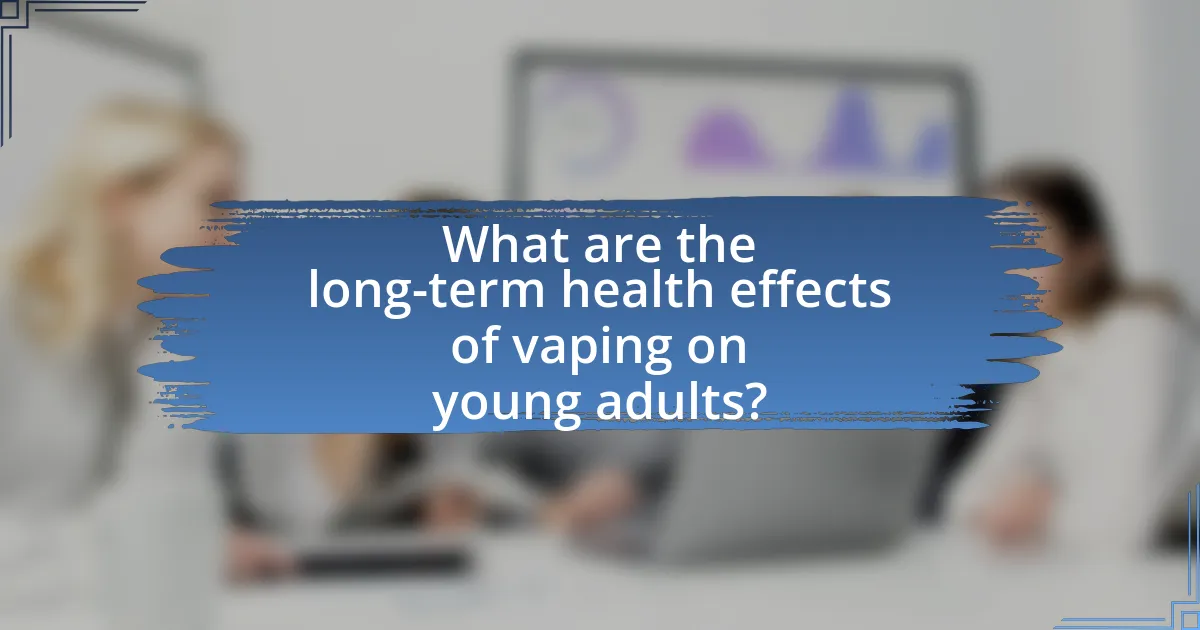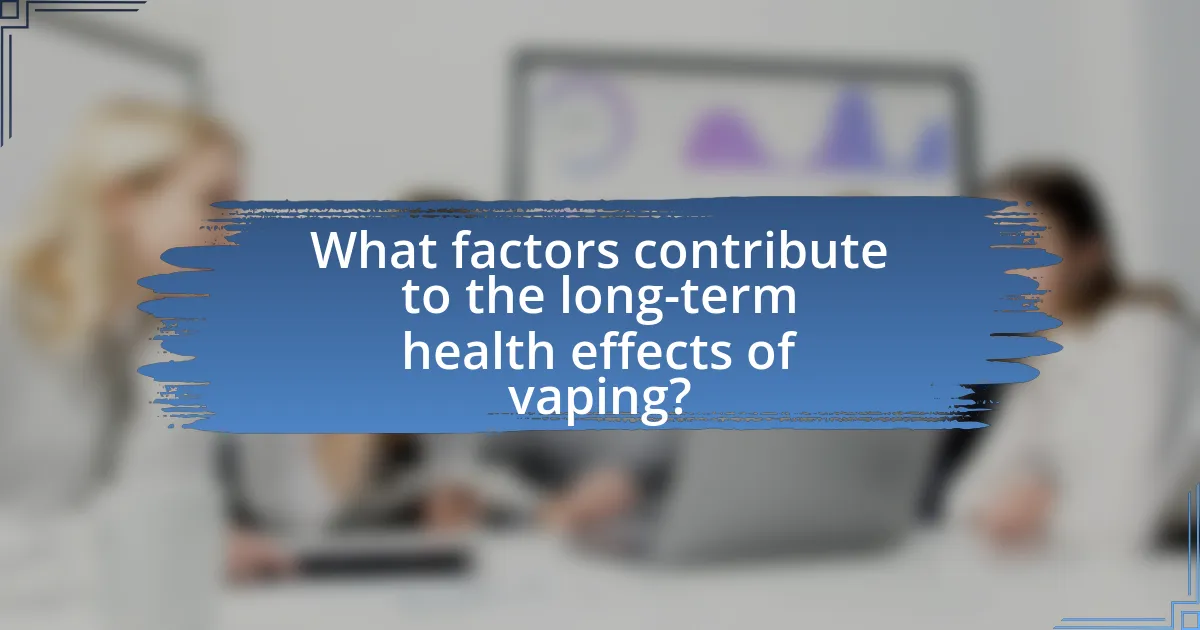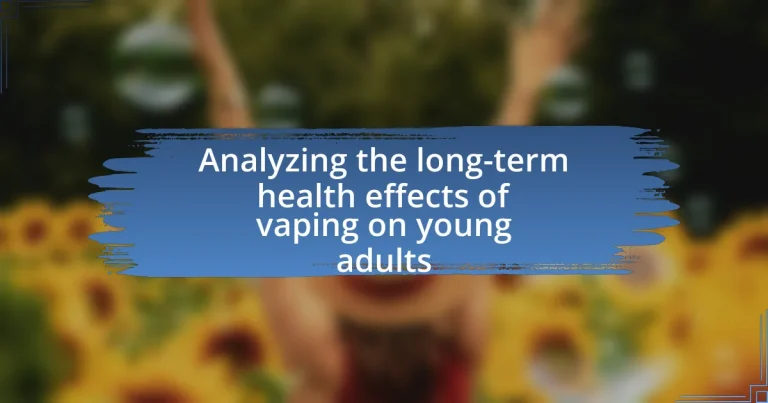The article analyzes the long-term health effects of vaping on young adults, highlighting significant concerns such as respiratory issues, cardiovascular problems, and nicotine addiction. It discusses how vaping can lead to chronic bronchitis, impaired lung function, and increased heart rate and blood pressure, contributing to cardiovascular diseases. Additionally, the article examines the mental health implications of vaping, including heightened anxiety and depression, and emphasizes the role of harmful substances in e-liquids. It concludes with recommendations for public health strategies, education, and policy changes aimed at reducing vaping prevalence and its associated health risks among young adults.

What are the long-term health effects of vaping on young adults?
The long-term health effects of vaping on young adults include respiratory issues, cardiovascular problems, and potential addiction to nicotine. Research indicates that vaping can lead to chronic bronchitis and decreased lung function due to the inhalation of harmful chemicals found in e-cigarettes. A study published in the journal Tobacco Control found that young adults who vape are at a higher risk of developing respiratory symptoms compared to non-vapers. Additionally, vaping has been linked to increased heart rate and blood pressure, which can contribute to cardiovascular diseases over time. Furthermore, the addictive nature of nicotine in vape products can lead to sustained use and dependence, impacting overall health and well-being.
How does vaping impact respiratory health in young adults?
Vaping negatively impacts respiratory health in young adults by causing inflammation and impairing lung function. Studies have shown that the inhalation of vaporized substances can lead to respiratory symptoms such as coughing, wheezing, and shortness of breath. For instance, research published in the journal Tobacco Control found that young adults who vape are more likely to experience respiratory issues compared to non-vapers. Additionally, the presence of harmful chemicals in e-cigarette aerosols, such as formaldehyde and acrolein, contributes to lung damage and increased susceptibility to respiratory infections.
What specific respiratory conditions are associated with vaping?
Vaping is associated with several specific respiratory conditions, including chronic bronchitis, asthma exacerbations, and vaping-associated lung injury (VALI). Chronic bronchitis is characterized by persistent cough and mucus production, which can be aggravated by the inhalation of harmful substances found in vape products. Asthma exacerbations can occur due to the irritants in vape aerosols, leading to increased wheezing and shortness of breath. Vaping-associated lung injury, identified in numerous cases, presents with symptoms such as cough, chest pain, and difficulty breathing, and has been linked to the inhalation of toxic substances like vitamin E acetate. These associations are supported by studies, including a report from the Centers for Disease Control and Prevention (CDC) that documented the rise in lung injuries related to vaping in 2019, highlighting the serious health risks posed by these products.
How does vaping compare to traditional smoking in terms of respiratory effects?
Vaping generally has fewer respiratory effects compared to traditional smoking. Traditional smoking exposes users to a wide range of harmful chemicals, including tar and carcinogens, which can lead to chronic obstructive pulmonary disease (COPD), lung cancer, and other serious respiratory issues. In contrast, vaping primarily delivers nicotine through vaporized e-liquids, which contain fewer toxic substances. Research indicates that while vaping is not without risks, it results in less inflammation and damage to lung tissue than smoking combustible tobacco products. A study published in the journal Tobacco Control found that e-cigarette users exhibited significantly lower levels of respiratory symptoms compared to cigarette smokers, highlighting the comparative safety of vaping in terms of respiratory health.
What cardiovascular risks are linked to vaping among young adults?
Vaping among young adults is linked to several cardiovascular risks, including increased heart rate, elevated blood pressure, and potential damage to blood vessels. Research indicates that the inhalation of nicotine and other harmful substances in e-cigarettes can lead to endothelial dysfunction, which is a precursor to cardiovascular disease. A study published in the Journal of the American College of Cardiology found that young adults who vape exhibit changes in arterial stiffness and vascular inflammation, both of which are significant risk factors for heart disease. Additionally, the presence of toxicants in vape products can contribute to oxidative stress, further exacerbating cardiovascular issues.
How does vaping affect heart health and blood pressure?
Vaping negatively affects heart health and blood pressure by increasing heart rate and blood pressure levels. Research indicates that the inhalation of nicotine and other harmful substances in e-cigarettes can lead to cardiovascular stress, resulting in elevated heart rates and increased blood pressure. A study published in the Journal of the American College of Cardiology found that young adults who vape exhibit higher systolic and diastolic blood pressure compared to non-vapers. Additionally, vaping has been linked to endothelial dysfunction, which is a precursor to cardiovascular diseases.
What studies have shown the cardiovascular effects of vaping?
Studies have shown that vaping has significant cardiovascular effects. For instance, a study published in the Journal of the American College of Cardiology in 2019 by Dr. Matthew J. Springer and colleagues found that e-cigarette use is associated with increased arterial stiffness, which is a risk factor for cardiovascular disease. Another research conducted by the American Heart Association in 2020 indicated that vaping can lead to endothelial dysfunction, impairing blood vessel function and increasing the risk of heart-related issues. These findings highlight the potential cardiovascular risks associated with vaping, particularly among young adults.
What mental health implications arise from vaping in young adults?
Vaping in young adults is associated with several mental health implications, including increased anxiety, depression, and stress. Research indicates that nicotine exposure from vaping can alter brain chemistry, leading to heightened feelings of anxiety and depressive symptoms. A study published in the journal “Psychological Medicine” found that young adults who vape are more likely to report mental health issues compared to non-vapers, with a 30% increase in the likelihood of experiencing anxiety disorders. Additionally, the social stigma and isolation associated with vaping can exacerbate these mental health challenges, creating a cycle of dependence and emotional distress.
How does nicotine in vaping products influence mental health?
Nicotine in vaping products negatively influences mental health by increasing anxiety and depressive symptoms. Research indicates that nicotine alters neurotransmitter systems, particularly dopamine and serotonin, which are crucial for mood regulation. A study published in the journal “Psychological Medicine” found that young adults who use nicotine products are at a higher risk for developing mood disorders, with a 30% increased likelihood of experiencing anxiety and depression compared to non-users. Additionally, nicotine dependence can lead to withdrawal symptoms that exacerbate mental health issues, creating a cycle of dependence and worsening psychological well-being.
What is the relationship between vaping and anxiety or depression?
Vaping is associated with increased levels of anxiety and depression among young adults. Research indicates that individuals who vape are more likely to experience mental health issues compared to non-vapers. A study published in the journal “Psychological Medicine” found that young adults who used e-cigarettes reported higher rates of anxiety and depressive symptoms, suggesting a significant correlation between vaping and mental health challenges. This relationship may stem from the nicotine in vaping products, which can affect mood regulation and exacerbate anxiety and depression.

What factors contribute to the long-term health effects of vaping?
The factors contributing to the long-term health effects of vaping include the chemical composition of e-liquids, the presence of harmful substances, and the frequency of use. E-liquids often contain nicotine, which is addictive and can lead to cardiovascular issues, while other chemicals like formaldehyde and acrolein can cause respiratory problems. Studies indicate that long-term exposure to these substances can result in chronic lung disease and cardiovascular complications. For instance, research published in the journal Tobacco Control highlights that vaping can lead to increased inflammation and oxidative stress in the lungs, which are precursors to serious health conditions. Additionally, the habitual nature of vaping among young adults can exacerbate these risks, leading to a higher likelihood of developing long-term health issues.
How do the ingredients in vape products affect health outcomes?
The ingredients in vape products significantly affect health outcomes by introducing harmful substances into the respiratory system. Common ingredients such as nicotine, propylene glycol, vegetable glycerin, and flavoring agents can lead to respiratory issues, cardiovascular problems, and potential addiction. Research published in the journal Tobacco Control indicates that exposure to these ingredients can cause inflammation and damage to lung tissue, increasing the risk of chronic obstructive pulmonary disease (COPD) and other respiratory illnesses. Additionally, nicotine has been shown to have neurotoxic effects, particularly in young adults, potentially impacting brain development and increasing the likelihood of substance dependence.
What harmful substances are commonly found in vaping liquids?
Harmful substances commonly found in vaping liquids include nicotine, formaldehyde, acrolein, and various heavy metals such as lead and cadmium. Nicotine is an addictive substance that can affect brain development in young adults. Formaldehyde, a known carcinogen, can form during the heating of propylene glycol and vegetable glycerin, which are common base liquids in vaping products. Acrolein, another toxic compound, can cause respiratory issues and is produced when glycerin is heated. Additionally, studies have detected heavy metals in vaping aerosols, likely originating from the heating elements used in devices, which pose further health risks.
How do flavorings in vape products impact health?
Flavorings in vape products can negatively impact health by introducing harmful chemicals that may lead to respiratory issues and other health problems. Studies have shown that many flavoring agents, such as diacetyl, are linked to serious lung conditions like “popcorn lung,” a disease that damages the small airways in the lungs. Additionally, flavorings can contribute to the formation of toxic compounds when heated, which can exacerbate inflammation and oxidative stress in the respiratory system. Research published in the journal Tobacco Control indicates that flavored e-cigarettes are particularly appealing to young adults, potentially increasing their risk of nicotine addiction and long-term health consequences.
What role does frequency and duration of vaping play in health effects?
Frequency and duration of vaping significantly influence health effects, with higher frequency and longer duration correlating with increased risks of respiratory and cardiovascular issues. Studies indicate that frequent vaping can lead to chronic bronchitis symptoms and impaired lung function, while prolonged exposure to nicotine and other chemicals in vape products heightens the likelihood of addiction and potential long-term health complications. For instance, research published in the journal Tobacco Control found that daily vaping is associated with a greater risk of developing respiratory symptoms compared to occasional use, highlighting the importance of both frequency and duration in assessing health outcomes.
How does the amount of vaping correlate with health risks?
The amount of vaping directly correlates with increased health risks, as higher consumption is associated with a greater likelihood of respiratory and cardiovascular issues. Research indicates that individuals who vape frequently are more likely to experience symptoms such as chronic bronchitis and reduced lung function. A study published in the journal Tobacco Control found that daily vaping significantly raises the risk of developing respiratory diseases compared to non-vapers. Additionally, the National Institute on Drug Abuse reports that increased nicotine exposure from frequent vaping can lead to addiction and other health complications.
What are the long-term effects of occasional versus regular vaping?
Occasional vaping generally leads to fewer long-term health effects compared to regular vaping, which is associated with significant risks. Regular vaping can result in chronic respiratory issues, cardiovascular problems, and potential addiction to nicotine, as evidenced by studies indicating that daily use increases the likelihood of developing these health complications. For instance, research published in the journal Tobacco Control found that individuals who vape regularly are more likely to experience lung inflammation and reduced lung function over time. In contrast, occasional users may still face some risks, but these are typically less severe and less likely to lead to long-term health consequences.

What are the implications for public health regarding vaping among young adults?
Vaping among young adults poses significant public health implications, primarily due to the associated risks of nicotine addiction and respiratory issues. Research indicates that young adults who vape are more likely to transition to traditional cigarette smoking, with a study published in the journal Tobacco Control revealing that 30% of young adult vapers eventually become regular smokers. Additionally, vaping can lead to lung damage; a report from the Centers for Disease Control and Prevention (CDC) highlighted cases of severe lung injury linked to vaping products, particularly those containing THC and vitamin E acetate. These health risks underscore the need for targeted public health interventions to mitigate the growing trend of vaping among young adults.
How can education and prevention strategies reduce vaping among young adults?
Education and prevention strategies can significantly reduce vaping among young adults by increasing awareness of the health risks associated with vaping and promoting healthier lifestyle choices. Research indicates that comprehensive educational programs that inform young adults about the dangers of nicotine addiction and respiratory issues linked to vaping can lead to a decrease in usage rates. For instance, a study published in the Journal of Adolescent Health found that participants who received targeted education about the harmful effects of vaping were 30% less likely to initiate vaping compared to those who did not receive such information. Additionally, prevention strategies that involve community engagement and peer-led initiatives have proven effective in creating a supportive environment that discourages vaping. These approaches not only provide factual information but also foster social norms that prioritize health and well-being, further contributing to reduced vaping rates among young adults.
What effective programs exist to discourage vaping in youth?
Effective programs to discourage vaping in youth include the Truth Initiative’s “Truth Campaign,” which utilizes impactful advertising and social media strategies to educate young people about the dangers of vaping. Research indicates that the Truth Campaign has significantly reduced youth smoking rates and increased awareness of the risks associated with vaping. Another program is the “Not on Tobacco” (N-O-T) program, developed by the American Lung Association, which provides a structured curriculum for teens to help them quit smoking and vaping. Studies show that participants in the N-O-T program have higher cessation rates compared to non-participants. Additionally, community-based initiatives, such as school-based prevention programs, have been effective in reducing vaping among adolescents by fostering peer support and providing accurate information about the health risks.
How can parents and educators address vaping in young adults?
Parents and educators can address vaping in young adults by implementing comprehensive education programs that focus on the health risks associated with vaping. Research indicates that young adults are more likely to understand the dangers of vaping when they receive clear, factual information about its long-term health effects, such as respiratory issues and potential addiction to nicotine. For instance, a study published in the journal Tobacco Control found that educational interventions significantly reduced vaping rates among adolescents. Additionally, parents and educators should foster open communication, encouraging young adults to discuss their experiences and concerns regarding vaping, which can lead to better understanding and prevention strategies.
What policies can be implemented to mitigate the health risks of vaping?
To mitigate the health risks of vaping, policies such as age restrictions, flavor bans, and public health campaigns can be implemented. Age restrictions prevent access to vaping products for individuals under 21, which has been shown to reduce usage rates among young adults. Flavor bans, as seen in states like Massachusetts, aim to eliminate appealing flavors that attract youth, thereby decreasing initiation rates. Public health campaigns can educate young adults about the potential health risks associated with vaping, utilizing data from studies that indicate increased respiratory issues and addiction rates among users. These combined strategies can effectively reduce the prevalence and health impacts of vaping among young adults.
What regulations are currently in place regarding vaping products?
Vaping products are regulated under various laws that vary by country and region. In the United States, the Food and Drug Administration (FDA) oversees the regulation of e-cigarettes and vaping products under the Family Smoking Prevention and Tobacco Control Act. This includes requirements for product registration, health warnings, and restrictions on marketing to minors. Additionally, many states have implemented their own regulations, such as age restrictions, flavor bans, and taxation on vaping products. For example, California has enacted laws that prohibit the sale of flavored tobacco products, including e-cigarettes, to reduce youth access. These regulations aim to mitigate the health risks associated with vaping, particularly among young adults.
How can policy changes improve public health outcomes related to vaping?
Policy changes can improve public health outcomes related to vaping by implementing stricter regulations on the sale and marketing of vaping products. These regulations can reduce youth access to vaping devices, as evidenced by studies showing that increased age restrictions correlate with lower usage rates among adolescents. For instance, after California raised the minimum legal age for tobacco sales to 21, youth vaping rates decreased significantly, demonstrating the effectiveness of such policies. Additionally, policies that mandate clear labeling and health warnings on vaping products can enhance consumer awareness about the potential risks, further discouraging use.
What practical steps can young adults take to minimize health risks associated with vaping?
Young adults can minimize health risks associated with vaping by choosing to quit or significantly reduce their use of e-cigarettes. Research indicates that vaping can lead to respiratory issues, cardiovascular problems, and potential addiction to nicotine. To support quitting, young adults can seek resources such as counseling, support groups, or nicotine replacement therapies, which have been shown to increase the likelihood of successful cessation. Additionally, they should educate themselves about the ingredients in vape products, as many contain harmful substances like diacetyl, which is linked to lung disease. By making informed choices and utilizing available support, young adults can effectively reduce their health risks related to vaping.


